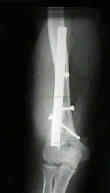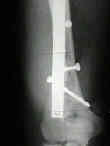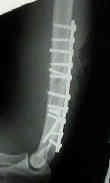- See:
- Anterior Approach to Humerus
- Posterior Approach to the Elbow;
- Plate Fixation of the Humerus;
- Pertinent Anatomy:
- radial nerve & profunda vessels pass across medial head of triceps; beneath long & lateral heads which then continues
distally to lateral humerus to pass into lateral intermuscular septum to enter flexor compartment;
- as noted by Gerwin, et al, nerve crosses posterior aspect of humerus at 20-21 cm proximal to medial epicondyle and 14-15 cm
proximal to lateral epicondyle;
- alternatively the nerve can be found a distance equal to the length of a 8 hole Synthes DC plate above olecranon fossa;
- nerve gives four branches to triceps, which arise in order:
- nerve to long head;
- nerve to medial head (#1);
- nerve to lateral head;
- lateral head arises just above the spiral groove (containing the radial nerve);
- typically multiple branches are sent to the lateral head of the triceps;
- nerve to medial heads (#2);
- medial head arises just below the spiral groove;
- nerves to long & medial heads will lie medial to incision line, & nerves to the lateral & medial (#2) heads to lateral side;
- of note, the radial nerve lies adjacent to the humerus w/o an intervening layer of muscle for a distance of 6-7 cm;
- ulnar nerve & brachial vessels will be seen above medial side of medial head of triceps if long head is retracted medially;
- note that the ulnar nerve supplies the medial head of the triceps, which allows the
medial head to be split down the mid-line, w/o resultant de-innervation;
- transposition of the radial nerve:
- references:
- Alternative Operative Exposures of the Posterior Aspect of the Humeral Diaphysis with Reference to the Radial Nerve.
- Posterior approaches to the humerus: when should you worry about the radial nerve?
- Anterior transposition of the radial nerve--a cadaveric study.
- Radial nerve location at the posterior aspect of the humerus: an anatomic study of 100 specimens
- Formal Posterior Approach:
- formal triceps splitting approach allows exposure upto 15-16 cm proximal to the lateral epicondyle (at which point the
radial nerve crosses the posterior humerus);
- additional mobilization of the radial nerve will allow an additional 6 cm of exposure;
- longitudinal incision is made posterior from a point 8 cm distal to the acromion down to the olecranon fossa;
- deep fascia is split in line with the incision;
- partial elevation of the triceps insertion on the olecranon is only necessary for fracture extension into the humeral condyles;
- look for posterior antebrachial cutaneous nerve - identified atthe posterior aspect of lateral intermuscular septum;
- exposure involves splitting fascia between long & lateral heads of triceps;
- frequently these two muscles will have a common tendon distally;
- identification of the proper interval is better identified proximally;
- tendinous interval between these muscles is split, and long head of triceps is retracted medially and lateral head
is retracted laterally;
- radial nerve should then be visible, lying deep in the spiral groove (along w/ profunda brachii vessels) just above insertion of
medial (deep) triceps;
- typically the radial nerve runs 15 cm above the lateral epicondyle;
- alternatively, the lateral head can be elevated laterally, which then allows radial nerve to be elevated in a superior direction;
- the superior dissection is limited by the brach of the radial nerve to the medial head of the triceps;
- this approach may allow upto 21 cm of safe dissection as measured from the lateral epicondyle;
- Modified Posterior Approach: (from Gerwin, et al (1996))
- allows exposure of upto 75-94% of the posterior humeral shaft or 26 cm of exposure above the lateral epicondyle;
- triceps is retracted medially to expose the lower lateral brachial cutaneous nerve;
- this nerve branches off the radial nerve on the posterior aspect of the lateral intermuscular septum;
- the branch is then traced to the main trunk of the radial nerve;
- divide the intermuscular septum around the nerve, to permit mobilization of the radial nerve;
- the medial and lateral heads of the triceps are then elevated off the humerus and then retracted medially;
- the radial nerve is retracted medially along with the triceps;
- this exposure can be carried upto the axillary nerve (usually 26 cm above the lateral epicondyle);
- as the radial nerve course around posterior aspect of the humerus one will find multiple branches to
the lateral head of the triceps, but there are no branches to the medial head of the triceps;
- as the nerve reaches the lateral aspect of the humerus, it divides into 3 branches, including one branch to the medial triceps;
- disadvantages:
- this approach may injure the variable brach of the radial nerve to the brachialis muscle
- references:
- Alternative Operative Exposures of the Posterior Aspect of the Humeral Diaphysis with Reference to the Radial Nerve.



A posterior surgical approach to the proximal part of the humerus.
- Anterior Approach to Humerus
- Posterior Approach to the Elbow;
- Plate Fixation of the Humerus;
- Indications:
- Distal Third Humeral Fractures:
- Humeral Mid-Shaft Frx are also amenable to the posterior approach if the formal approach is modified (see below);
- Pertinent Anatomy:
- radial nerve & profunda vessels pass across medial head of triceps; beneath long & lateral heads which then continues
distally to lateral humerus to pass into lateral intermuscular septum to enter flexor compartment;
- as noted by Gerwin, et al, nerve crosses posterior aspect of humerus at 20-21 cm proximal to medial epicondyle and 14-15 cm
proximal to lateral epicondyle;
- alternatively the nerve can be found a distance equal to the length of a 8 hole Synthes DC plate above olecranon fossa;
- nerve gives four branches to triceps, which arise in order:
- nerve to long head;
- nerve to medial head (#1);
- nerve to lateral head;
- lateral head arises just above the spiral groove (containing the radial nerve);
- typically multiple branches are sent to the lateral head of the triceps;
- nerve to medial heads (#2);
- medial head arises just below the spiral groove;
- nerves to long & medial heads will lie medial to incision line, & nerves to the lateral & medial (#2) heads to lateral side;
- of note, the radial nerve lies adjacent to the humerus w/o an intervening layer of muscle for a distance of 6-7 cm;
- ulnar nerve & brachial vessels will be seen above medial side of medial head of triceps if long head is retracted medially;
- note that the ulnar nerve supplies the medial head of the triceps, which allows the
medial head to be split down the mid-line, w/o resultant de-innervation;
- transposition of the radial nerve:
- references:
- Alternative Operative Exposures of the Posterior Aspect of the Humeral Diaphysis with Reference to the Radial Nerve.
- Posterior approaches to the humerus: when should you worry about the radial nerve?
- Anterior transposition of the radial nerve--a cadaveric study.
- Radial nerve location at the posterior aspect of the humerus: an anatomic study of 100 specimens
- Position: lateral position, injured side up;
- Formal Posterior Approach:
- formal triceps splitting approach allows exposure upto 15-16 cm proximal to the lateral epicondyle (at which point the
radial nerve crosses the posterior humerus);
- additional mobilization of the radial nerve will allow an additional 6 cm of exposure;
- longitudinal incision is made posterior from a point 8 cm distal to the acromion down to the olecranon fossa;
- deep fascia is split in line with the incision;
- partial elevation of the triceps insertion on the olecranon is only necessary for fracture extension into the humeral condyles;
- look for posterior antebrachial cutaneous nerve - identified atthe posterior aspect of lateral intermuscular septum;
- exposure involves splitting fascia between long & lateral heads of triceps;
- frequently these two muscles will have a common tendon distally;
- identification of the proper interval is better identified proximally;
- tendinous interval between these muscles is split, and long head of triceps is retracted medially and lateral head
is retracted laterally;
- radial nerve should then be visible, lying deep in the spiral groove (along w/ profunda brachii vessels) just above insertion of
medial (deep) triceps;
- typically the radial nerve runs 15 cm above the lateral epicondyle;
- alternatively, the lateral head can be elevated laterally, which then allows radial nerve to be elevated in a superior direction;
- the superior dissection is limited by the brach of the radial nerve to the medial head of the triceps;
- this approach may allow upto 21 cm of safe dissection as measured from the lateral epicondyle;
- Modified Posterior Approach: (from Gerwin, et al (1996))
- allows exposure of upto 75-94% of the posterior humeral shaft or 26 cm of exposure above the lateral epicondyle;
- triceps is retracted medially to expose the lower lateral brachial cutaneous nerve;
- this nerve branches off the radial nerve on the posterior aspect of the lateral intermuscular septum;
- the branch is then traced to the main trunk of the radial nerve;
- divide the intermuscular septum around the nerve, to permit mobilization of the radial nerve;
- the medial and lateral heads of the triceps are then elevated off the humerus and then retracted medially;
- the radial nerve is retracted medially along with the triceps;
- this exposure can be carried upto the axillary nerve (usually 26 cm above the lateral epicondyle);
- as the radial nerve course around posterior aspect of the humerus one will find multiple branches to
the lateral head of the triceps, but there are no branches to the medial head of the triceps;
- as the nerve reaches the lateral aspect of the humerus, it divides into 3 branches, including one branch to the medial triceps;
- disadvantages:
- this approach may injure the variable brach of the radial nerve to the brachialis muscle
- references:
- Alternative Operative Exposures of the Posterior Aspect of the Humeral Diaphysis with Reference to the Radial Nerve.



A posterior surgical approach to the proximal part of the humerus.
Posterior approaches to the humerus: when should you worry about the radial nerve?

